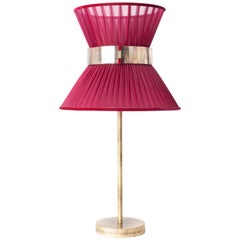Sabrina Landini Sale
Recent Sales
21st Century and Contemporary Italian Modern Wall Mirrors
Art Glass, Mirror, Wood
21st Century and Contemporary Italian Modern Table Lamps
Brass
Sabrina Landini Sale For Sale on 1stDibs
How Much is a Sabrina Landini Sale?
Sabrina Landini for sale on 1stDibs
Italian designer Sabrina Landini is best known for her seductive handmade decorative objects and lighting. Supported by a small team of assistants in Tuscany, Landini creates bright and optimistic modernist pieces that reflect strong femininity. Her eponymous brand's elegant Tiffany series of lighting fixtures — a celebrated line that includes table lamps, floor lamps and more — is inspired by Audrey Hepburn’s iconic character in 1961’s Breakfast at Tiffany’s.
Landini grew up in Montelupo, Italy, not far from Florence. As a child, she enjoyed watching her father work as a glassmaker. She became fascinated by the way he transformed silicon powder into bright objects of crystal and glass.
As an adult, Landini moved to Milan, Italy, and opened a modest studio in the Navigli area. Landini created her first home furnishing at this workshop in Navigli — a light fixture that would be the inaugural piece in her Tiffany line. Topped with handcrafted hourglass-shaped lampshades made of organza silk or fine fabrics such as satin — and gathered at the center by a signature belt of silvered glass — the aged brass-stemmed Tiffany lamps are Landini’s trademark design, the one she is most proud of. While the Tiffany series draws on the Hepburn film, her Butterfly hanging fixtures and Sunshine floor lamps feature natural-world motifs and are inclusive of colored glass panes, handmade Japanese paper and Art Deco–inspired hardware.
Later, Landini moved to Pietrasanta, Tuscany, and opened an atelier. As a designer, she wanted to imbue her modern pieces with the rich heritage of Tuscan art. Today Landini and her team work with a range of rich materials — crystals, silks, precious stones and more — to create one-of-a-kind functional designs for storage cabinets, tables, mirrors and other furniture and decor.
On 1stDibs, explore authentic Sabrina Landini chandeliers, wall decorations, seating and more.
A Close Look at modern Furniture
The late 19th and early 20th centuries saw sweeping social change and major scientific advances — both of which contributed to a new aesthetic: modernism. Rejecting the rigidity of Victorian artistic conventions, modernists sought a new means of expression. References to the natural world and ornate classical embellishments gave way to the sleek simplicity of the Machine Age. Architect Philip Johnson characterized the hallmarks of modernism as “machine-like simplicity, smoothness or surface [and] avoidance of ornament.”
Early practitioners of modernist design include the De Stijl (“The Style”) group, founded in the Netherlands in 1917, and the Bauhaus School, founded two years later in Germany.
Followers of both groups produced sleek, spare designs — many of which became icons of daily life in the 20th century. The modernists rejected both natural and historical references and relied primarily on industrial materials such as metal, glass, plywood, and, later, plastics. While Bauhaus principals Marcel Breuer and Ludwig Mies van der Rohe created furniture from mass-produced, chrome-plated steel, American visionaries like Charles and Ray Eames worked in materials as novel as molded plywood and fiberglass. Today, Breuer’s Wassily chair, Mies van der Rohe’s Barcelona chair — crafted with his romantic partner, designer Lilly Reich — and the Eames lounge chair are emblems of progressive design and vintage originals are prized cornerstones of collections.
It’s difficult to overstate the influence that modernism continues to wield over designers and architects — and equally difficult to overstate how revolutionary it was when it first appeared a century ago. But because modernist furniture designs are so simple, they can blend in seamlessly with just about any type of décor. Don’t overlook them.

